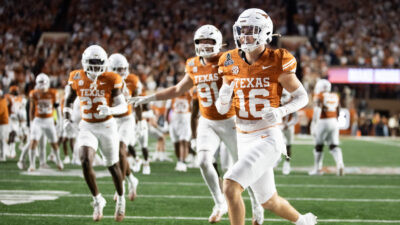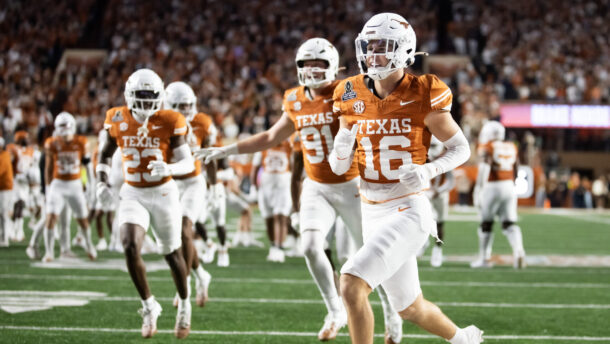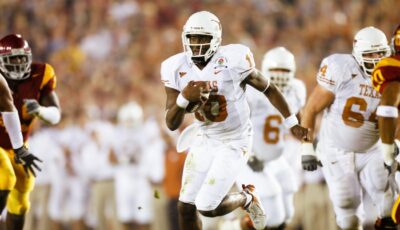
If I asked anyone outside of Tuscaloosa in 2019 about who they’d rather have between Mac Jones and Justin Fields in 2020, they would’ve laughed me out of the room.
Check that. They would’ve laughed me out of any shred of credibility I had.
To be honest, I couldn’t have asked the Jones vs. Fields question with a straight face before 2020.
Therein lies the beauty of actually playing football games.
While some outside of Tuscaloosa might still laugh me out of the room for asking that question, especially after Fields had an all-time great performance in the Sugar Bowl against Clemson, it is a legitimate discussion topic heading into the College Football Playoff National Championship.
Jones or Fields?
To be clear, we’re talking about a 1-game scenario here. This isn’t just about who has had the better college career or who will have the better NFL career, though if you just look at the former, it’s incredible to think about how close it is:
Highest-graded QBs since 2019:
🥇 Mac Jones – 93.6
🥈 Justin Fields – 93.5 pic.twitter.com/TILDtIUNdU— PFF College (@PFF_College) January 5, 2021
This argument is about who has the advantage on Monday night when it’s for all the marbles. That seems like as big a factor as any to decide the national championship in this era of high-octane offenses.
In the last 10 title games, how many times has the quarterback who played better finished on the losing side? Maybe 2015? But even then, Jake Coker threw for over 300 yards and he averaged 13.4 yards per attempt while Deshaun Watson was Deshaun Watson.
In the Playoff era, all but 1 of the 6 winners hit at least 35 points in the title game. The one that didn’t was 2017 Alabama, which scored 26 points in the second half and overtime after Tua Tagovailoa was put into the game at the break. Nick Saban benching his 2-year starter and former SEC Offensive Player of the Year Jalen Hurts in favor of the better passing quarterback flipped the script of that title game.
Neither Jones nor Fields are trending in the direction of Jalen Hurts, who struggled to develop as a passer in Brian Daboll’s offense. So assuming both players are out there for 60 minutes, who has the better shot at shining on the national stage? Let’s break that down.
More likely to make a costly mistake
Both quarterbacks are incredibly accurate having completed north of 73% of their passes this year. Pinpoint accuracy isn’t lacking. Rare it is that we see an overthrown ball or a pass without enough mustard lead to a turnover. Jones and Fields, in the rare instance that they make a mistake, usually have some sort of miscommunication with their target.
But Jones only threw an interception once every 89.3 passes in 2020 while Fields turned it over once every 32 passes. Against the 3 good defenses he faced (Indiana, Northwestern and Clemson), Fields threw at least 1 pick in every game. He had multiple interceptions in the well-documented grinds against Indiana and Northwestern.
The other thing with Fields that can be troublesome is the amount of sacks he takes. Fields took multiple sacks in every game he played in 2020. Jones attempted almost twice as many passes, yet he basically took half as many sacks (11) as Fields (20). Why? It’s release time.
Adjusted Completion %
1. Justin Fields 81.3%
2. Mac Jones 80.2%Via @PFF_College …Minimum 50 dropbacks. 193 QBs qualified
What’s the major difference though? Release time.
Mac Jones ball out 38th fastest
Justin Fields ball out 185th fastest— Ben Fennell (@BenFennell_NFL) January 4, 2021
Fields likes to hold on to the ball and let plays develop, in part because more times than not, he can make pass-rushers miss. It’s a totally different style than Jones, who has the luxury of throwing screens to DeVonta Smith (he caught more screen passes than any FBS player).
It feels weird to say that Fields is more likely to make a mistake considering he’s coming off a game in which he had as many touchdown passes (6) as incompletions against Brent Venables’ defense, but Jones has played virtually mistake-free football all year. He’s had at least 71% passing in 10 of Alabama’s 12 games this year, and he’s taken multiple sacks in a game just twice. (Both were against top-10 teams and he still made sure to hit 400 passing yards and at least 4 touchdown passes with 75% passing.) Jones is one of just 3 FBS quarterbacks with at least 350 pass attempts and fewer than 10 turnover-worthy plays (PFF).
So yeah, Fields is more likely to put himself in one of those spots to make a costly mistake.
ADVANTAGE — Jones
More likely to make a play when things break down
OK, you know it’s Fields, but it’s probably closer than you realize. Jones has been phenomenal in this department all year, which is partially responsible for the low sack/interception totals. The Alabama junior performed extremely well under pressure this year.
This might not be a total breakdown with a free rusher coming at his face, but Jones’ ability to sense backside pressure and find someone who isn’t his first read is darn impressive:
Mac Jones building that Heisman resume 👀 @MacJones_10 @AlabamaFTBL
(via @CBSSports)pic.twitter.com/GBTnCg2eYL
— The Checkdown (@thecheckdown) November 28, 2020
Jones doesn’t really let plays totally break down. Part of that is his offensive line, and part of that is because he understands when he has a mismatch on the outside.
Having said that, Fields is still so exceptional at making something out of nothing. The entire reason that Fields was in position to take that shot to his ribs against Clemson was because things broke down on 3rd-and-13, and he was 2 yards from picking up a first down with his legs.
If you don’t account for Fields in that way and just drop everyone into coverage, yeah, he can burn you and gut your defense on third down:
Justin Fields run on 3rd-and-11. pic.twitter.com/0hRa02ad3j
— Derrik Klassen (@QBKlassClips) November 26, 2019
But it’s the throws on the run that make Fields special. He can beat you on anywhere on the field, and he’s remarkably accurate outside the pocket.
You can’t teach this stuff:
😲 WOW 😲
Gus Johnson was all of us watching @Justnfields return from injury to throw a dime pic.twitter.com/TW6E6269lE
— FOX College Football (@CFBONFOX) December 1, 2019
ADVANTAGE — Fields
More proven in 2020
Jones was a Heisman Trophy finalist and Fields wasn’t, and that wasn’t just because the former played 5 more games. Jones had one of the most efficient seasons we’ve ever seen at the quarterback position (he’s currently No. 5 all-time in yards per attempt). Even if you want to break down the per/game averages, Fields doesn’t have the advantage in any major passing category.
Yes, Fields certainly had a better year as a runner, but he only averaged 45 rushing yards per game. That doesn’t make up for the passing disparity, where Jones’ has had such a high floor this year.
That consistency certainly shows up in the Pro Football Focus grades:
Highest-graded QBs in 2020:
1) Mac Jones, Bama – 95.5
2) Zach Wilson, BYU – 95.4
3) Justin Fields, Ohio St – 93.3
4) Spencer Rattler, OU – 92.7
4) Grayson McCall, Coastal – 92.7 pic.twitter.com/gsfaqpVZcL— PFF College (@PFF_College) January 4, 2021
Here’s a little historical perspective on that grade for Jones, which is now up to 95.5 after his 4-touchdown performance against Notre Dame:
Highest-graded season by a P5 QB
1. Mac Jones (2020) – 95.3
2. Joe Burrow (‘19) – 94.9🏆
3. Kyler Murray (‘18) – 94.6🏆
3. Baker Mayfield (‘17) – 94.6🏆 pic.twitter.com/yrXHOgF4xi— PFF College (@PFF_College) December 22, 2020
It’s not a slight to Fields to say that there were some legitimate questions about him before that Clemson game. He had 5 interceptions in the 2 games against teams that finished with winning records. Compare that to Jones, who had 4 interceptions all year and in the 4 games he played (and won) against teams with a New Year’s 6 Bowl bid, he averaged 392 passing yards, 4.3 touchdown passes and 11.9 yards per attempt.
You can say that Fields had the better overall individual game of 2020 because of what he just did against Clemson. But for the entire season, that argument belongs to Jones.
ADVANTAGE — Jones
More battle-tested on the big stage
Going into a season, I’m always interested in which quarterbacks lead the way in combined conference championship/New Year’s 6/Playoff game experience. At least as a starter. It’s a good estimate of what a player does in a game that has legitimate stakes against quality competition.
(I’m not going to count Fields’ SEC Championship as a mark in his favor, which I’m sure he wouldn’t mind after the fake punt fiasco.)
Jones started in 2 conference championship/New Year’s 6/Playoff games. Fields’ number is now at 4. More importantly, Fields is now 3-1 in those games with the lone loss being the controversial non-fumble against Clemson in last season’s Fiesta Bowl. Here’s the comparison of Jones and Fields in “big-stage” games:
| Big-stage games | Jones | Fields |
| Record | 2-0 | 3-1 |
| TD-INT | 9-1 | 10-5 |
| Passing yards/game | 358 | 280 |
| Yards/attempt | 9.8 | 8.5 |
| Rushing yards/game | 2 | 23 |
Jones definitely has any sort of statistical advantage on Fields, who struggled for essentially 75% of the 2 Big Ten Championships he played in (don’t forget how brutal he looked against that Wisconsin defense early in the 2019 conference title game). There’s also no doubt that Fields needed a backup running back to go off in order to keep Ohio State’s Playoff hopes alive against Northwestern.
The reason this isn’t a slam dunk for Jones is admittedly a touch of recency bias. Fields’ Clemson game should’ve squashed any notion that he can’t perform on the big stage. With the college football world ready to pounce on unproven Ohio State, he delivered a performance for the ages. That has to count for something.
Jones just has such a smaller sample size in these big-stage games. He looked exceptional against a bad Florida defense, and he was solid once again in the Rose Bowl against an elite Notre Dame defense.
But this is, for now, too close to call because of the variance in sample size.
ADVANTAGE — Tie
More favorable defensive matchup
Staring down either one of these defensive lines wouldn’t be fun. Fields will become familiar with Christian Barmore and Jones will become familiar with Haskell Garrett (assuming he’s healthy enough to play). Both teams are capable of generating pressure without bringing heat from the second level. We saw that throughout the semifinal games.
But when Clemson had its scripted plays early on before the absence of offensive coordinator Tony Elliott was truly felt, the plan was obvious; make Ohio State defend the edges. Whether that was finding that swing route out of the backfield, hitting a receiver on a quick screen or attacking downfield on the sidelines with Amari Rodgers, the Tigers put on a clinic of how to beat Ohio State’s defense early on. They attacked Shaun Wade’s cushion and forced Ohio State to cover the entire field. Granted, the Tigers couldn’t sustain that and they became 1-dimensional with that suspect run blocking.
That’s where Jones should be able to absolutely tee off. It feels like we’ve watched Smith do this countless times in 2020:
DeVonta Smith made them miss and found the end zone ⚡️ pic.twitter.com/ybWaWBdzNT
— ESPN (@espn) January 1, 2021
Alabama executes these plays because not only does it have an accurate quarterback and a capable ball-carrier to weave in and out of traffic, but it also has wide receivers who are excellent downfield blockers. That play only happens if John Metchie is blocking 25 yards past the line of scrimmage.
Jones also has the luxury of dumping it off to Najee Harris, who can just as easily take over as a receiver if left unaccounted for out of the backfield. With Florida so focused on containing Smith and Metchie, Harris had 3 receiving touchdowns in the SEC Championship.
WHAT A SPIN BY Najee Harris #SECChampionshipGame Alabama Or Florida? Who y’all got? 🤝 #Florida #alabamafootball @AlabamaFTBL @GatorsFB pic.twitter.com/52iVz58SvW
— scaryhourssss (@scaryhourssss) December 20, 2020
Fields will likely have his fair share of success against the Alabama pass defense. Against offenses that could actually stretch the field vertically like Florida and Ole Miss, Alabama surrendered 40-plus. This isn’t the early 2010s when hitting 30 on Alabama was worthy of enshrinement.
But at least we’ve seen the Alabama pass defense, led by All-American Patrick Surtain, stymie lesser offenses. The Crimson Tide went over 300 minutes without allowing a passing touchdown going into the SEC Championship. That’s an absurd feat in 2020. Ohio State, on the other hand, ranks No. 116 in FBS defending the pass. If that’s not the worst pass defense of any team playing in a national championship, that’s news to me.
Trevor Lawrence still threw for 400 yards in the semifinal. It wasn’t like the Buckeyes, who surrendered 491 passing yards in a home game against Indiana, figured anything out on the back end.
As much improvement as the Ohio State defensive line has shown lately in the post-Chase Young era, I’m not sure how that can’t favor Jones.
ADVANTAGE — Jones
More feared with the game on the line
Both quarterbacks usually spend the fourth quarter with a headset on and a towel around their necks, so this is a bit tough to gauge. Jones technically doesn’t have a 4th quarter comeback win as a starter. He doesn’t even have a second-half comeback. The only time he trailed in the 4th quarter was the 2019 Iron Bowl, which was a loss. Since that game, Alabama is 13-0 having won all but 1 game by at least 15 points. And of course the 1 game that wasn’t decided by 15 points was against Florida, which never led.
Fields, however, has been faced with a second-half deficit 3 times. Go figure that his 2 wins were in the Big Ten Championship, and his loss was last year’s Clemson game.
INTERCEPTION!@ClemsonFB‘s Nolan Turner picks off Justin Fields in the end zone to seal it! #ALLIN pic.twitter.com/yLjSAPErPW
— ACC Network (@accnetwork) December 29, 2019
Ever since the miscommunication with Chris Olave, which he admitted was on him and not Fields, those 2 have been perfectly in sync. (Olave was out with COVID for the Northwestern game.) Nobody in the Big Ten had a higher passer rating when targeted than Olave, and that was before he went off for 132 yards and 2 touchdowns against Clemson (PFF).
That’s not to say that’s a better connection than Jones and Smith, but considering what Fields and Olave went through over the last year, I wouldn’t doubt them being on the same page Monday night.
I’d also think it’d be tougher to defend Fields in that spot when he’s capable of stopping the clock by using his legs to pick up a first down and/or then get out of bounds. That’s a dangerous arsenal in a 2-minute drill.
For that reason, I’ll give the edge to Fields ahead of Jones, who hasn’t been put in those spots much in his career.
ADVANTAGE — Fields
So what did all of this show?
That in a 1-game scenario, I’d give Jones the slightest advantage over Fields.
That, boys and girls, is a sentence I never thought I’d type.
But when you break down all of those factors, it becomes clear that Jones’ weaknesses are few and far between. Maybe he doesn’t have quite the big-stage experience that Fields does, but in a smaller sample size, the Alabama signal-caller outperformed his counterpart in that area. That’s true despite the fact that Fields just showed more upside in a 60-minute window than we’ve ever seen from him.
Again, though, this is why you actually play the games (and watch them). We’ve seen Fields get more confused by coverages than Jones. Everyone has tried throwing the kitchen sink at Alabama, and still, we’ve seen historic consistency. As in, consistency that we didn’t even see with Tua Tagovailoa.
Jones might not make highlight-reel plays like Fields, and he’s not going to rip off a 45-yard touchdown run like Fields or Lawrence, but this argument is about winning a title; it’s not about drafting a franchise quarterback. You can’t just say it’s about who would you want getting the ball in the final 2 minutes because if the other 58 minutes are lopsided, it really doesn’t matter who is better in crunch time.
I’ll take Jones for 60 minutes knowing that Fields could easily laugh me out of the room by night’s end.
Connor O'Gara is the senior national columnist for Saturday Down South. He's a member of the Football Writers Association of America. After spending his entire life living in B1G country, he moved to the South in 2015.







